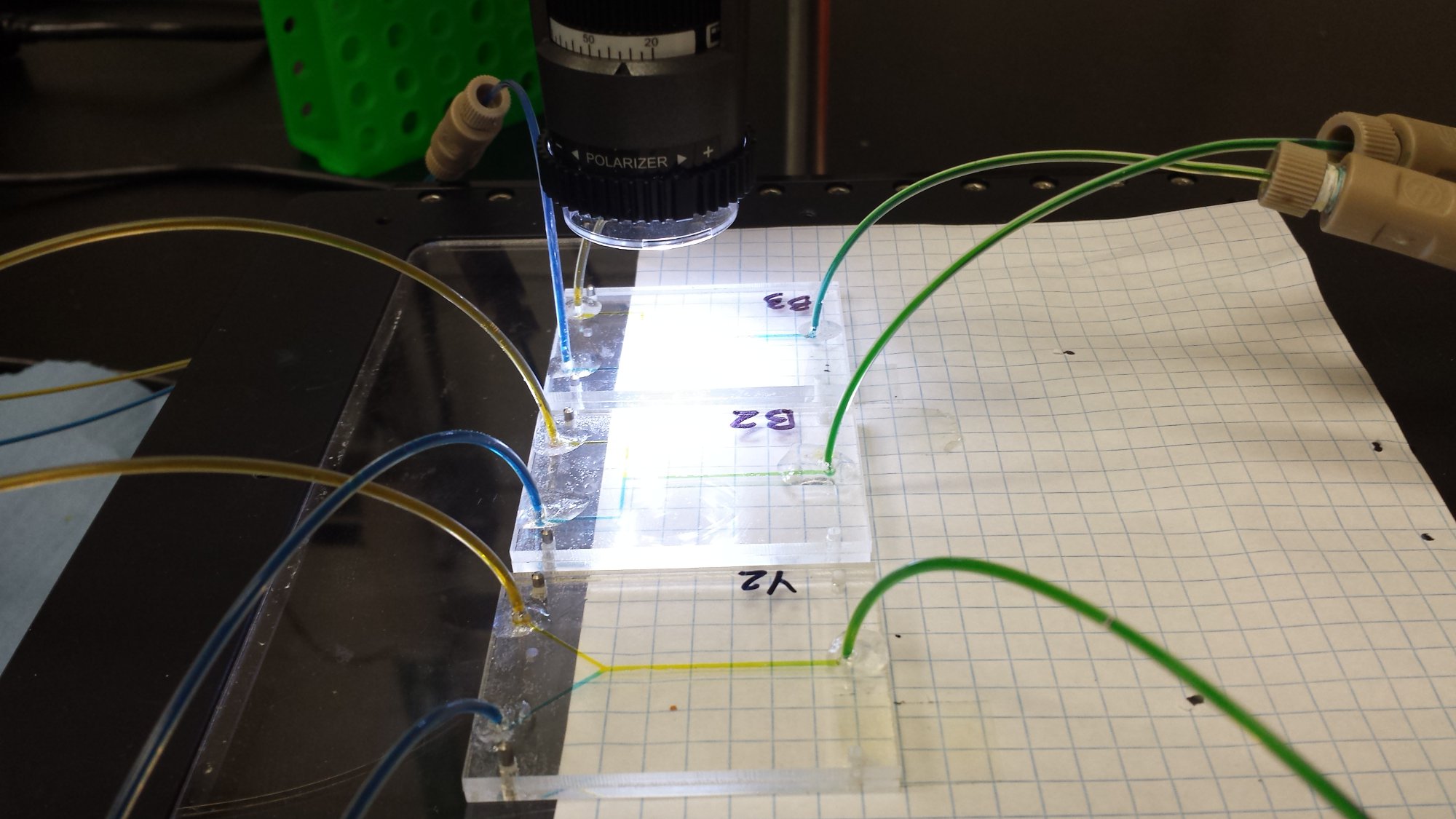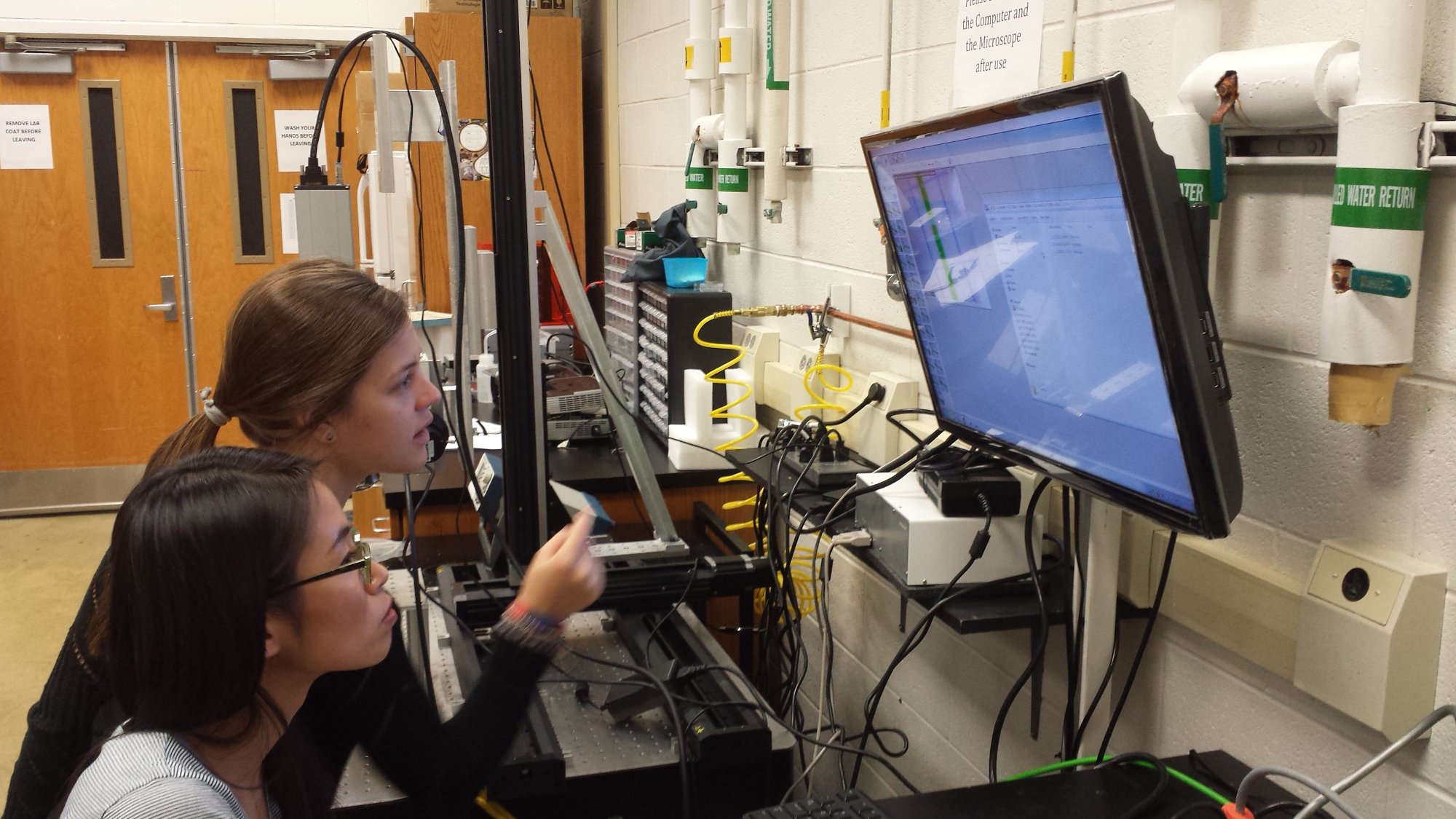trapping Chagas
by Jemma Everyhope-Roser
photos courtesy of Rodrigo Martinez-Duarte
Rodrigo Martinez-Duarte, an assistant professor of mechanical engineering, and student researchers Josie Duncan, Andraia Li, Natalie Hanson and Kayla Wallace hope to fashion a trap for the parasite that causes Chagas disease.
At night, the kissing bug hosting the Chagas parasite emerges from the woodworks to feast upon its sleeping victims. Left behind on the victim’s skin, the single-celled flagellate protozoan that causes Chagas, Trypanosoma cruzi, gets rubbed into a wound or mucus membrane, like those within the eyes. T. cruzi starts replicating in the victim’s blood. At this stage, when Chagas disease is acute, T. cruzi is relatively easy to find and possible to cure with a round of antibiotics. Yet the initial infection’s symptoms, if there are any, are so nonspecific that the infection often goes undetected. After a few weeks or months, this phase subsides; the disease becomes chronic. T. cruzi can settle on the heart and colon, biding its time for decades. About 20 to 30 percent of people with chronic Chagas will later experience what is thought to be an overwhelming—and fatal—immune response.
“The scary part is,” Martinez-Duarte says, “after twenty or thirty years of being infected, a patient can just drop dead.”
Several million people are currently infected, and T. cruzi is thought to kill about fourteen thousand per year in Latin America, where it is endemic. Other routes for Chagas disease infection include blood transfusions, food contaminated by the parasite, and congenital transmission, as it is passed through the blood of the umbilical cord from mother to child. Over 26 percent of new infections are thought to be congenital, and by cutting this line of transmission, Martinez-Duarte and these students hope to help end Chagas.
The current rapid tests used to detect Chagas disease resemble pregnancy tests, Martinez-Duarte says, but they’re only accurate about 90 percent of the time. Recently, there have also been concerns that these tests give false positives, confusing the diagnoses of Chagas with Leishmania, another trypanosome parasite that requires very different treatment.
Martinez-Duarte says that student interest in finding true solutions to real-world problems, like developing a better device for diagnosing Chagas, prompted him to start the Creative Inquiry project that has now lasted over three semesters and drawn in students from a variety of fields. Individuals from mechanical engineering, microbiology, genetics, chemical engineering, bioengineering, and even nursing, have participated in this Creative Inquiry project.
An interesting fact about this engineering project is, that “historically, we have had maybe seventeen students involved with the project, and only two have been men. That’s a good sign,” Martinez-Duarte says.
These student researchers, by bringing their expertise from a variety of fields into this project, enrich it. Some, being in labs, regularly do things like cell culturing—something that Martinez-Duarte, as an engineer, wasn’t previously as familiar with. He says, “If you get a team of only engineers, they’ll sometimes start diverging. Students from different backgrounds help keep the whole team focused on the project’s application.”

The experimental platforms, currently composed of acrylic plates and a patterned, double-sided adhesive, are connected to syringe pumps to flow different colored solutions and create a gradient in the microfluidic chip.
Li, a biology major, says, “I like working with engineers. I feel like they’re pretty pragmatic with their decisions.” Li goes on to say that she shares more in common with her fellow student researchers than not. Hanson of bioengineering, Wallace of biology, and Duncan of mechanical engineering all use the scientific method to develop protocol and to seek solutions in developing this new diagnostic tool.
For this device to be applicable, it will have to be cheap and robust and able to withstand high heats and have a long shelf life. It will have to be easy to use, with clear results.
In the current prototype, acrylic plastic sandwiches a double-sided adhesive, which is basically a double-sided tape. These acrylic plates were cut in a mini-mill, basically a CNC machine, and have holes bored into them to align them and interface them with a syringe pump. The group uses a cutter plotter, such as might be seen in a mall making personalized stickers, to cut specific patterns into the double-sided tape, patterns that will be used to establish the microfluidics. The channels draw the liquids through them, and the group can slide these devices under the microscope to watch their workings.
“Initially, the idea was that the chips would have some sort of chemo-attractant that the parasite would be drawn to, and we would flow that through the chip,” Hanson says. “However, the gradient that we’re trying to flow through is so slow, it’s not very reliable or reproducible. The results aren’t that accurate.”
The next step, Martinez-Duarte says, is to put the parasite inside and see how it reacts to different stimuli. The goal is to learn more about this parasite and be able to concentrate it in specific locations. Duncan adds that discovering more about this under-researched parasite is a priority, as the literature currently doesn’t give much guidance.
That’s why the team, with the addition of four new members this semester—Alisha Kifer, Anna Pitman, Emily Kluttz, and Aylin Alvarez—has been reaching out to James Morris, who studies T. brucei, also a trypanosome parasite, but one that causes African sleeping sickness.
In another example of how this project inspires interdisciplinary cooperation, Morris has been training Martinez-Duarte’s group on culturing and handling trypanosome parasites. The Martinez-Duarte group plans to use T. brucei as a model to begin their experiments on, before moving on to the more dangerous T. cruzi that they wish to trap and conquer.
Once they’re working with T. cruzi itself, they’ll start their search for the perfect attractant, one that will bring T. cruzi—and T. cruzi alone—to a specific location in the diagnostic device. Hanson says, “We are focusing our efforts on finding the right stimuli. It has been a struggle to find something this bug is uniquely drawn to in papers.”
The team is starting to explore the attraction of the parasite to paraffin following a report in the literature. T. cruzi is known to have a positive cytoskeleton, so the student researchers are interested in paraffin because it’s negatively charged.
Once the group has discovered a reliable gradient that affects only this particular parasite, Martinez-Duarte says, “We can have a robust device where you put a sample of blood, and once you know that it will attract the parasite, then we can know on which specific spots it will land. We could then detect the parasite with an inexpensive microscope.”
Even though T. cruzi isn’t hard for trained personnel to pick out amongst the chaos in a normal blood sample, the rural areas where people are most affected by Chagas are less likely to have such expertise readily at hand. Martinez-Duarte says, “We’re trying to make a device that a midwife delivering a baby in rural Latin America can use, where she or he can take a drop of blood, put it into this device, and quickly be able to tell if the parasite is there or not.”
“I want people to be more aware of the importance of developing alternative ways to detect diseases,” Li adds, “because a lot of the world’s population lives in these rural areas and doesn’t have access to labs and equipment.”
Interest in solving these real-world problems typifies the mindset Martinez-Duarte searches for in the students that join his group. He wants students, like these, who can get to the other side of the learning curve, students who will see problems and who will continually seek new solutions. As for the students themselves, Li, for one, enjoys being in a group that’s passionate, where ideas are thrown around, where everyone has their own perspective, and not every perspective agrees. Hanson says, about working on this project, that “there’s a lot of trial and error,” but she’s learned that’s part of science—and research.
“It’s not easy trying to find a solution,” Wallace says. “You always have to go deeper. You have to figure out the whys.”
“I tell them from the beginning,” Martinez-Duarte says, “this is research, so don’t expect me to have all the answers, because I don’t. We have to struggle together, find a solution together, and educate each other. They have been up to the challenge.”



